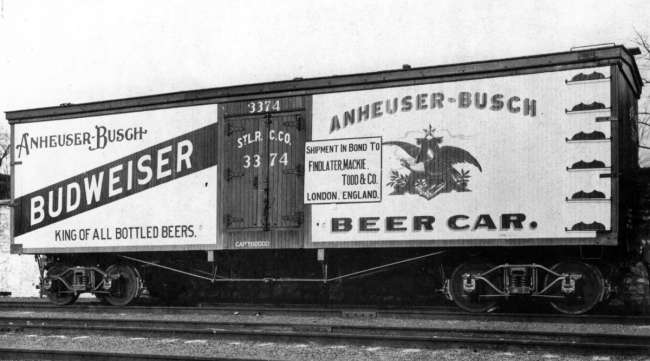Anheuser-Busch: A Timeline

The relationship between large-scale breweries, such as Anheuser-Busch, and organized labor stretches back more than a century to the early days of brewing in the United States and provides a rare example of long-term, peaceful coexistence between employers and union officials.
Author Dane Hucklebridge, in a book titled “The United States of Beer,” cites the “liberal spirit of progressive politics and social organization” of German-speaking immigrants to America following a failed revolution in Europe in 1848 for creating an environment that boosted the position of brewery workers and helped the fledgling industry take off.
“The very earliest attempts at organized labor can be found as far back as the 1850s,” Hucklebridge wrote, “when German workers began forming trade associations and mutual aid societies in St. Louis and Cincinnati. In the latter city, workers would form the Bruer Gesellen Union in 1879, lobbying for and eventually winning through boycotts a reduction of the workday and increase in the minimum wage.”
In 1886, brewery workers formed the National Union of United Brewery Workers, an entity that held sway in the Midwest for close to a century until it merged with longtime rival, the Teamsters union, in 1973.
“Happy workers produce good beer and breweries were generally able to expand their production without the ugly growing pains seen in other, more exploitive industries like coal and steel,” Hucklebridge said.
Innovations in transportation had a big influence on the development of the beer industry, according to Peter Liebhold, a curator for the Division of Work and Industry at the National Museum of American History.
“Beer is heavy and bulky and is sometimes temperature-sensitive,” Liebhold said. “Product distribution has always been a big challenge for brewers, and transportation figures into the rise of national brands.”
Anheuser-Busch was the first American brewer to use pasteurization and, in the mid-1870s introduced artificial refrigerated and rail-side icehouses to distribute beer over long distances. The company launched the first national beer brand, Budweiser, in 1876.
Brewing soon became a big business as consumption of beer rose in response to demographic changes with the influx of German immigrants, the rise of saloon culture and lower prices as brewers centralized production and expanded distribution by the use of trucks in the 20th century.
“Beer was once very local,” Liebhold recalled. “My grandfather’s first job was walking to the neighborhood brewery at lunch time and bringing back two pails of beer on a yoke for his relatives. Beer could be shipped in barrels by train and delivered in wagons, but trucks sure made the whole thing easier.”
The onset of national prohibition on Jan. 16, 1920, led to the closure of more than half of the nation’s breweries.
To survive, Anheuser-Busch sold yeast and malt syrup, produced root beer and other nonalcoholic drinks, made ice cream and even manufactured truck bodies.
With the repeal of prohibition in 1933 came new regulations that to this day require brewers to sell only to independent wholesalers that in turn provide the product to retail stores and taverns.
The three-tier distribution system, which is subject to oversight by various state regulatory authorities, was designed to prevent brewers from exerting too much control over beer served in restaurants and bars.
The importance of distributors has grown with an increase in recent years of craft breweries, according to Maureen Ogle, author of “Ambitious Brew: The Story of American Beer.”
“Distributors are the kingpins,” Ogle said in an interview with Transport Topics.
Today the International Brotherhood of Teamsters represent 19,068 workers in the beer industry, another 8,125 in wine and liquor distribution, 36,162 in the soft drink industry and about 1,200 workers in manufacturing of cans and bottles and distribution of tobacco.
For more than 30 years, Anheuser-Busch has been signatory to a national labor contract with the Teamsters that covers brewery workers, plus employees at 14 wholesale distributors and even handlers for the iconic Clydesdale horses that are featured in Budweiser commercials.
Dave Laughton, who has headed up the Teamsters’ Brewery and Soft Drink Conference since 1968, said workers at Anheuser-Busch are “well-compensated” with medical benefits and company-funded retirement plans. Many employees have spent their whole working lives at Anheuser-Busch.
The Teamsters have called only two strikes against Anheuser-Busch over the years, with the last one coming in 1976. The current five-year labor contract expires in 2019.
Laughton said he’s convinced that the union and management can continue to work together to meet challenges posed by automation and changes in business strategies.
Some of the workers affected by automation could transfer to jobs in other breweries, Laughton said, while others could receive severance pay or take early retirement.
An ongoing challenge for the union, Laughton said, is to organize workers at small craft breweries that have become a focus of investment at Anheuser-Busch and other beer producers in the United States.

